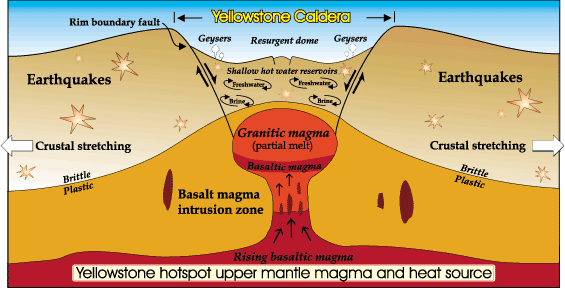|
|
 At Yellowstone and some other volcanoes, some
scientists theorize that the earth's crust fractures and cracks
in a concentric or ring-fracture pattern. At some point these
cracks reach the magma “reservoir,” release the pressure,
and the volcano explodes. The huge amount of material released
causes the volcano to collapse into a huge crater—a caldera.
The Hydrothermal System of Geyser BasinsYellowstone's hydrothermal features wouldn't exist without the underlying magma body that releases tremendous heat. They also depend on sources of water. In the high mountains surrounding the Yellowstone Plateau, water falls as snow or rain and slowly percolates through layers of porous rock. Some of this cold water meets hot saline brine that is directly heated by the shallow magma body. The water's temperature rises well above the boiling point but the water remains in a liquid state due to the great pressure and weight pushing down on it from overlying rock and water. The result is superheated water with temperatures exceeding 400 degrees Fahrenheit. The superheated water is less dense than the colder, heavier water sinking around it. This creates convection currents that allow the lighter, more buoyant, superheated water to begin its slow journey back to the surface following the cracks, fissures, and weak areas through rhyolitic lava flows. As hot water travels through the rock, high temperatures dissolve some silica in the rhyrolite. While in solution underground, some of this silica deposits as geyserite, coating the walls of the cracks and fissures to form a nearly pressure-tight seal. This locks in the hot water and creates a "plumbing system" that can withstand the great pressure needed to produce a geyser. Select How Geysers Work to see an animation of the process (138K). Back to tour | Hotspot Theories | Yellowstone's Hotspot | Anatomy of a Geyser | Anatomy of a Hot Spring | How Geysers Work (138K) |
|
|